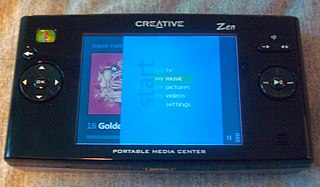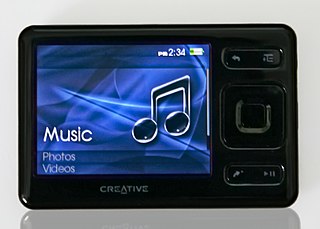Related Research Articles
XScale is a microarchitecture for central processing units initially designed by Intel implementing the ARM architecture instruction set. XScale comprises several distinct families: IXP, IXC, IOP, PXA and CE, with some later models designed as system-on-a-chip (SoC). Intel sold the PXA family to Marvell Technology Group in June 2006. Marvell then extended the brand to include processors with other microarchitectures, like ARM's Cortex.
The NOMAD was a range of digital audio players designed and sold by Creative Technology Limited, and later discontinued in 2004. Subsequent players now fall exclusively under the MuVo and ZEN brands.
PowerPC G4 is a designation formerly used by Apple and Eyetech to describe a fourth generation of 32-bit PowerPC microprocessors. Apple has applied this name to various processor models from Freescale, a former part of Motorola. Motorola and Freescale's proper name of this family of processors is PowerPC 74xx.

Portable Media Center (PMC) is a portable media player (PMP) platform developed by Microsoft. Announced at the 2003 Consumer Electronics Show (CES), and released in early 2004, it was originally positioned as a competitor to Apple's iPod. All its hard drive-based players use a graphical user interface (GUI) modeled after Media Center, a software portal bundled with Windows XP Media Center Edition. Manufacturers of PMC devices included Creative, Philips, iriver, Samsung, and Toshiba.

ZEN is a series of discontinued portable media players designed and manufactured by Creative Technology Limited. The players evolved from the NOMAD brand through the NOMAD Jukebox series of music players, with the first separate "ZEN" branded models released in 2004. The last Creative Zen player, X-Fi3, was released at the end of 2011.

The iPod Shuffle is a discontinued digital audio player designed and formerly marketed by Apple Inc. It was the smallest model in Apple's iPod family, and was the first iPod to use flash memory. The first model was announced at the Macworld Conference & Expo on January 11, 2005; the fourth- and final-generation models were introduced on September 1, 2010. The iPod Shuffle was discontinued by Apple on July 27, 2017.

A portable media player (PMP) is a portable consumer electronics device capable of storing and playing digital media such as audio, images, and video files. The data is typically stored on a compact disc (CD), Digital Video Disc (DVD), Blu-ray Disc (BD), flash memory, microdrive, or hard drive; most earlier PMPs used physical media, but modern players mostly use flash memory. In contrast, analogue portable audio players play music from non-digital media that use analogue media, such as cassette tapes or vinyl records.

SigmaTel was an American system-on-a-chip (SoC), electronics and software company headquartered in Austin, Texas, that designed AV media player/recorder SoCs, reference circuit boards, SoC software development kits built around a custom cooperative kernel and all SoC device drivers including USB mass storage and AV decoder DSP, media player/recorder apps, and controller chips for multifunction peripherals. SigmaTel became Austin's largest IPO as of 2003 when it became publicly traded on NASDAQ. The company was driven by a talented mix of electrical and computer engineers plus other professionals with semiconductor industry experience in Silicon Hills, the number two IC design region in the United States, after Silicon Valley.
The following comparison of portable media players compares general and technical information for notable digital playback devices.

The ZEN Vision:M was a portable media player developed by Creative Technology, and was launched on December 8, 2005. The device's features and interface was adapted from the earlier released ZEN Vision with a smaller screen size and dimensions.

The ZEN V and the ZEN V Plus are portable media players manufactured by Creative Technology. The user interface on this player, the same as the one on Creative's ZEN Vision:M, was patented by Creative on January 9, 2005. Creative sued Apple over the use of this user interface; Apple later settled for $100 million.
The PowerPC e600 is a family of 32-bit PowerPC microprocessor cores developed by Freescale for primary use in high performance system-on-a-chip (SoC) designs with speed ranging over 2 GHz, thus making them ideal for high performance routing and telecommunications applications. The e600 is the continuation of the PowerPC 74xx design.

The ZEN is a portable media player designed and manufactured by Creative Technology. This flash memory-based player is the de facto successor of the ZEN Vision:M and was announced on August 29, 2007, to be available in capacities of 2, 4, 8, and 16 GB, as of September 14. A 32 GB model was announced on December 4, 2007, setting a record for storage capacity among flash players. The ZEN is referred to also by the identifier DVP-FL0001 though this does not appear on the unit.
The i.MX range is a family of Freescale Semiconductor proprietary microcontrollers for multimedia applications based on the ARM architecture and focused on low-power consumption. The i.MX application processors are SoCs (System-on-Chip) that integrate many processing units into one die, like the main CPU, a video processing unit and a graphics processing unit for instance. The i.MX products are qualified for automotive, industrial and consumer markets. Most of them are guaranteed for a production lifetime of 10 to 15 years.
Many devices use i.MX processors, such as Ford Sync, Kobo eReader, Amazon Kindle, Zune, Sony Reader, Onyx Boox readers/tablets, SolidRun SOM's, Purism's Librem 5, some Logitech Harmony remote controls and Squeezebox radio, some Toshiba Gigabeat mp4 players. The i.MX range was previously known as the "DragonBall MX" family, the fifth generation of DragonBall microcontrollers. i.MX originally stood for "innovative Multimedia eXtension".
Sigma Designs was an American public corporation that designed and built high-performance system-on-a-chip semiconductor technologies for Internet-based set-top boxes, DVD players/recorders, high-definition televisions, media processors, digital media adapters, portable media players and home connectivity products. In addition to platform processing and home network hardware, Sigma Designs also offered engineering support services and customized integrated circuit development.
Creative Technology Ltd. is a Singaporean multinational technology company headquartered with overseas offices in Shanghai, Tokyo, Dublin, and Silicon Valley. The principal activities of the company and its subsidiaries consist of the design, manufacture and distribution of digitized sound and video boards, computers and related multimedia and personal digital entertainment products. It also partners with mainboard manufacturers and laptop brands to embed its Sound Blaster technology on their products.
Actions Semiconductor Co. Ltd. is a Chinese fabless semiconductor company founded in 2000 and headquartered in Zhuhai, Guangdong province. The company has about 600 employees and designs SoCs for tablets, digital audio players, photo viewers and related products.
Vivante Corporation is a fabless semiconductor company headquartered in Sunnyvale, California, with an R&D center in Shanghai, China. The company was founded in 2004 as GiQuila and focused on the portable gaming market. The company's first product was a DirectX-compatible graphics processing unit (GPU) capable of playing PC games. In 2007, GiQuila changed its name to Vivante and changed the direction of the company to focus on the design and licensing of embedded graphics processing unit designs. The company is licensing its Mobile Visual Reality to semiconductor solution providers that serve embedded computing markets for mobile gaming, high-definition home entertainment, image processing, and automotive display and entertainment.

Integrated Device Technology, Inc., is an American corporation headquartered in San Jose, California, that designs, manufactures, and markets low-power, high-performance mixed-signal semiconductor solutions for the advanced communications, computing, and consumer industries. The company markets its products primarily to original equipment manufacturers (OEMs). Founded in 1980, the company began as a provider of complementary metal-oxide semiconductors (CMOS) for the communications business segment and computing business segments. The company is focused on three major areas: communications infrastructure, high-performance computing, and advanced power management.

Zen 2 is a computer processor microarchitecture by AMD. It is the successor of AMD's Zen and Zen+ microarchitectures, and is fabricated on the 7 nanometer MOSFET node from TSMC. The microarchitecture powers the third generation of Ryzen processors, known as Ryzen 3000 for the mainstream desktop chips, Ryzen 4000U/H and Ryzen 5000U for mobile applications, as Threadripper 3000 for high-end desktop systems, and as Ryzen 4000G for accelerated processing units (APUs). The Ryzen 3000 series CPUs were released on 7 July 2019, while the Zen 2-based Epyc server CPUs were released on 7 August 2019. An additional chip, the Ryzen 9 3950X, was released in November 2019.